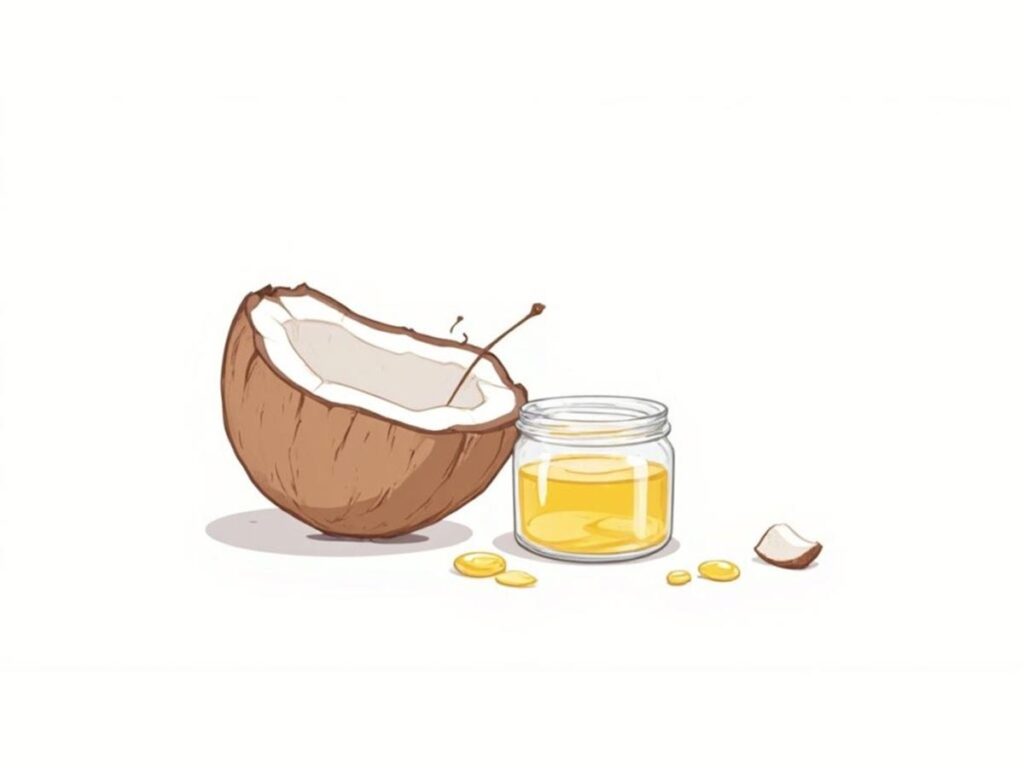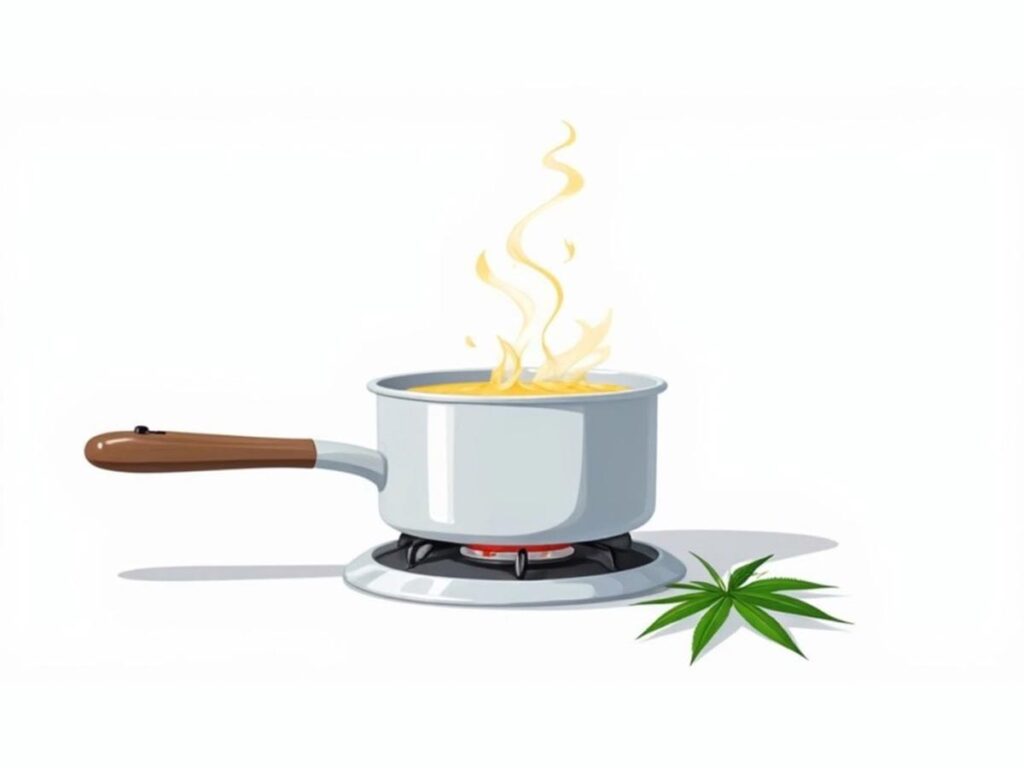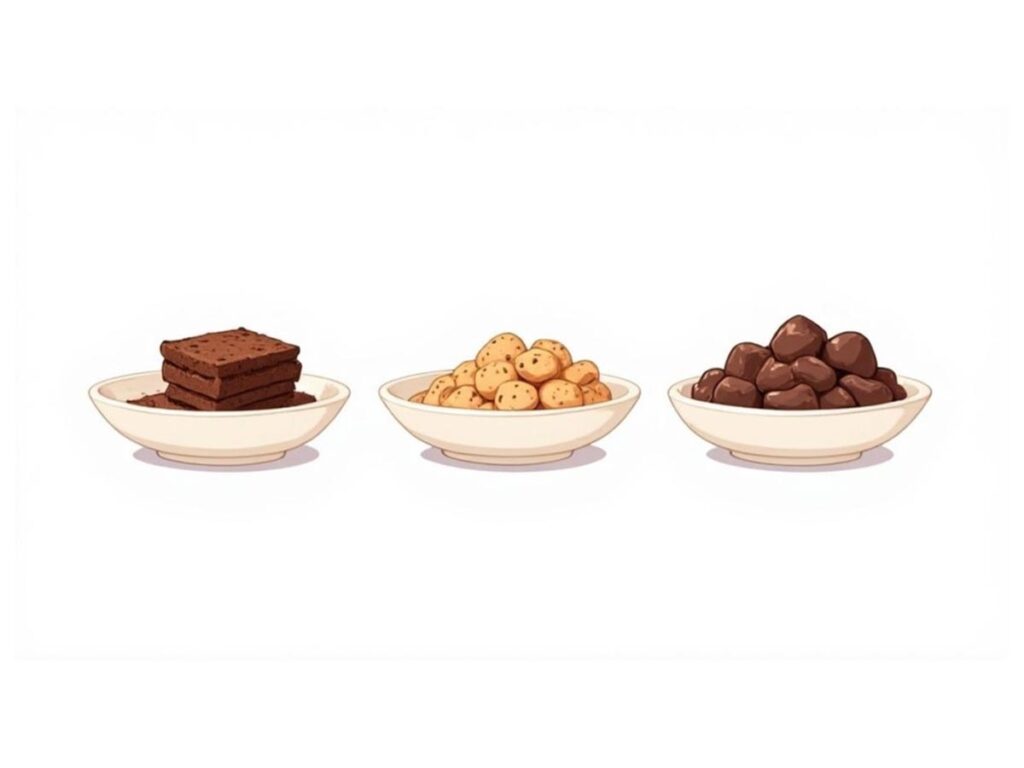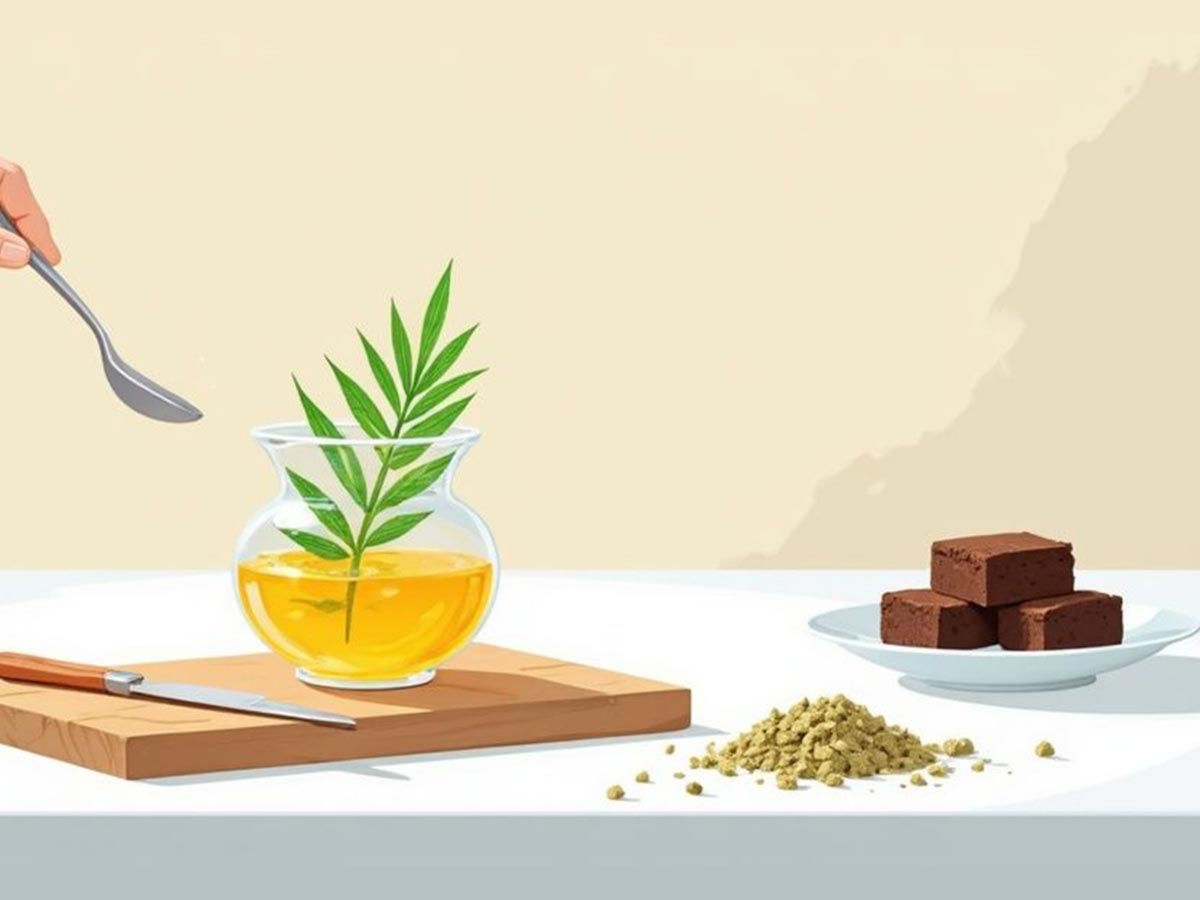Ready to unlock the secret to amazing homemade edibles? When you craft your own, you’re in complete control—you dictate the ingredients, the potency, and every nuance of flavor. Mastering your own cannabis coconut oil is the foundational skill for this culinary adventure, opening up a world of possibilities from decadent baked goods to soothing homemade topicals.
Your Starting Point for Homemade Cannabis Edibles

Consider this your personal playbook for creating consistently potent and delicious infused oil. I’ll guide you through the process with clear, actionable steps. We’ll start by exploring why coconut oil is the perfect partner for cannabis. Then, we’ll dive into the most crucial step: decarboxylation, the simple process that “activates” your flower for maximum effect.
Finally, I’ll walk you through a foolproof infusion method that guarantees a clean, powerful oil every time. By the end of this guide, you’ll have the confidence and inspiration to start experimenting with your own cannabis coconut oil recipes, turning your kitchen into a personal edibles lab.
The Rise of Infused Oils
This isn’t just a niche kitchen hobby anymore; infused oils are at the heart of a booming wellness market. The global CBD oil and consumer health market—which frequently uses coconut oil as a carrier—was valued at USD 78.03 billion in 2025 and is projected to reach an impressive USD 207.07 billion by 2029. This explosive growth is fueled by wider legalization, the convenience of online shopping, and a growing cultural acceptance of cannabis.
This huge shift really points to how much people want to take wellness into their own hands. When you make your own canna-oil, you’re doing more than just cooking—you’re part of a major cultural and economic movement.
If you’re just starting out, building a solid foundation is key. Check out our beginner-friendly guide to cannabis—it’s packed with the essential knowledge you’ll need to feel comfortable and confident on your journey.
What to Expect From This Guide
My goal here is to empower you with the skills to make consistently great cannabis coconut oil. We’re going to cover everything you need to know, including:
- Choosing Your Ingredients: Discover how to select the right cannabis and coconut oil to achieve your desired effects and flavors.
- Activation is Key: I’ll provide a simple, step-by-step process for decarboxylation that’s practically impossible to mess up.
- Foolproof Infusion: Learn proven methods for infusing your oil that eliminate any risk of scorching it.
- Delicious Recipes: We’ll finish with easy and effective ways to use your brand-new infused oil in your favorite dishes.
Choosing Your Core Ingredients Wisely
The secret to a phenomenal edible begins long before you turn on the stove. It all boils down to two critical choices: your cannabis and your coconut oil. Getting these right lays the groundwork for an infused oil that’s not just potent but also tastes incredible.
What Kind of Cannabis Should You Use?
Let’s start with the star of the show: the cannabis. The strain you choose directly influences the final experience of your edibles.
Are you aiming for a deeply relaxing, couch-melting vibe to unwind at the end of the day? An Indica-dominant strain is your perfect match. But if you’re seeking an energetic, creative spark to fuel a productive afternoon, a Sativa-dominant strain is the way to go.
Beyond the Indica vs. Sativa distinction, consider the cannabinoid profile. High-THC flower delivers that classic, potent psychoactive effect. In contrast, a CBD-rich strain is ideal for creating infusions with more therapeutic, non-intoxicating benefits. For many, a balanced 1:1 ratio of THC to CBD offers the perfect middle ground.
Picking the Perfect Coconut Oil
Now, let’s talk about the carrier oil. Coconut oil is a top-tier choice for infusions because its high saturated fat content excels at binding to cannabinoids like THC and CBD. As defined by sources like Wikipedia, these fats act as highly effective carriers, ensuring you get a potent and efficient infusion. But even within the world of coconut oil, you have options.
You’ll generally see two types on the shelf:
- Unrefined (Virgin) Coconut Oil: This is the less processed option, retaining its characteristic tropical coconut flavor and aroma. It’s perfect when you want that taste to be a feature, like in a batch of infused chocolate macaroons.
- Refined Coconut Oil: This version is processed to remove the coconut flavor, resulting in a completely neutral oil. It’s the ideal choice for savory dishes or any recipe where you don’t want the taste of coconut to interfere.
Your decision here can significantly shape your final product. To simplify your choice, here’s a quick comparison.
Comparing Cannabis and Coconut Oil Options
This table breaks down cannabis types and coconut oil options to help you select the best ingredients for your desired edible experience.
| Ingredient | Key Characteristics | Best For… | Flavor Profile |
|---|---|---|---|
| Indica-dominant Cannabis | Known for relaxing, sedative effects. | Evening use, pain relief, sleep aids. | Earthy, skunky, or sweet. |
| Sativa-dominant Cannabis | Known for uplifting, energetic effects. | Daytime use, creative boosts, social settings. | Fruity, citrusy, or spicy. |
| Unrefined Coconut Oil | Minimally processed, strong coconut flavor. | Baked goods, desserts, and tropical dishes. | Distinctly tropical and sweet. |
| Refined Coconut Oil | Processed to be neutral in flavor and aroma. | Savory dishes, gummies, or anything where you want the cannabis flavor to dominate. | Completely neutral. |
Ultimately, the right combination depends entirely on your goals for both the effect and the flavor of your edibles.
The global demand for coconut oil really speaks to its versatility. The market was valued at about USD 5.49 billion in 2025 and is expected to hit USD 7.61 billion by 2029, which just goes to show how much of a staple it is in kitchens everywhere.
While coconut oil is my go-to for many infusions, don’t feel limited to it. Other fats work really well, too. If you want to experiment with different tastes, our guide on how to make cannabis olive oil is a great next step for exploring savory flavor profiles.
Mastering Decarboxylation for Maximum Potency

Alright, this is where the real transformation happens. If you want your cannabis coconut oil to deliver its full potential, decarboxylation is the one step you absolutely cannot skip. It may sound like complex chemistry, but it’s an incredibly simple process you can easily do in your oven.
Here’s the science made simple: raw cannabis flower contains a compound called Tetrahydrocannabinolic acid (THCA). While THCA has its own set of properties, it is non-psychoactive. To unlock the classic euphoric effects of THC, you need to apply heat. This gentle heating process converts the inactive THCA into active THC.
Skip this step, and you’ll end up with a weak, ineffective oil, regardless of how much premium flower you use. The good news? All you need is your oven and a little patience.
The Ideal Oven Method
Perfecting the temperature and time is everything. Too hot, and you risk burning off the very cannabinoids and terpenes you’re trying to activate. Too low, and the conversion from THCA to THC simply won’t happen efficiently.
Through extensive testing, I’ve found the sweet spot is 240°F (115°C) for about 40 to 45 minutes.
This low-and-slow approach gently activates the THC while preserving the delicate terpenes that give your cannabis its unique aroma and flavor profile.
Mastering decarboxylation is the single most important skill for making consistent edibles. Once you nail this, you’ll be able to create powerful cannabis coconut oil that delivers reliable effects every single time.
Prepping Your Cannabis for Activation
A little preparation goes a long way toward ensuring an even “bake” and maximum potency. Here’s a quick, actionable checklist to get your flower ready.
- Break It Down: Start by gently breaking up your cannabis buds into smaller, popcorn-sized pieces with your hands. Avoid grinding it into a fine powder at this stage, as this increases the risk of scorching.
- Create an Even Layer: Spread the pieces evenly across a baking sheet lined with parchment paper. This ensures every bit of the flower receives consistent heat.
- Cover It Up: Lightly tent the baking sheet with aluminum foil. This helps trap just enough heat for an even decarb and has the added benefit of containing some of the distinct aroma.
As your cannabis bakes, you’ll notice a distinct transformation. It will shift from a vibrant green to a lovely toasted, golden-brown color, and your kitchen will fill with a rich, nutty scent. These are the tell-tale signs that your activation is on the right track.
Once the timer goes off and your flower looks perfectly toasted, it’s officially activated and ready for infusion.
Bringing Your Canna-Oil to Life
You’ve successfully decarboxylated your cannabis, and now it’s time for the most rewarding part—the infusion. This is where we gently transfer all those activated cannabinoids from the plant into rich coconut oil, creating a potent, versatile base for countless recipes.
The process itself is straightforward, but the key ingredient is patience. You must embrace a “low and slow” philosophy. Rushing the process by cranking up the heat will scorch the oil and destroy the very compounds you worked so hard to activate. The result? A bitter, weak oil and a waste of good flower. Trust me, the shortcut is never worth it.
Pick Your Potion-Making Method
You don’t need a high-tech lab to create incredible canna-oil. In fact, you probably have everything you need in your kitchen already. Here are the three most reliable and common methods.
- The Slow Cooker (Crock-Pot): This is my personal favorite. It’s the ultimate “set-it-and-forget-it” tool. The slow, consistent heat over several hours is perfect for a deep, thorough infusion without any risk of burning. If you’re multitasking, this is your best friend.
- The Double Boiler: For those who prefer more hands-on control, the double boiler is a fantastic choice. It uses steam to gently heat the oil, making it virtually impossible to overheat. It requires a bit more attention than a slow cooker but offers complete peace of mind.
- The Simple Saucepan: This is the traditional method, but it’s also the trickiest. You’re working with direct heat, which demands constant vigilance. I only recommend this if you’re confident in maintaining a very low temperature and are prepared to stir frequently.
No matter which method you choose, the core principle is the same: combine your decarbed flower and coconut oil, and let them infuse on low heat for at least 2-3 hours. A longer infusion can extract more cannabinoids for a more potent oil, but it may also introduce a stronger, more “plant-like” flavor.
Straining: The Final Polish
Once your infusion is complete and has cooled enough to handle safely, it’s time to separate the oil from the plant material. Your goal is a beautifully clear, smooth oil without any residual grit.
Place a few layers of cheesecloth over a clean glass jar or bowl (a fine-mesh strainer also works). Carefully pour your oil mixture through the cheesecloth and let gravity do the work. It may be tempting to squeeze the cheesecloth to get every last drop, but resist the urge! This is a classic beginner’s mistake. Squeezing forces chlorophyll and other plant matter into the oil, which is what causes that harsh, grassy flavor.
A little patience here pays huge dividends in the final taste of your edibles.
The quality of your ingredients directly impacts the final cost and flavor. For example, between January and July 2025, crude coconut oil prices shot up by about 33% due to supply shortages. This kind of market shift shows how important it is to source your ingredients wisely for both budget and quality. Discover more insights about these price dynamics and what they mean for consumers.
How Strong Is My Oil? Nailing the Dose
Figuring out the potency of your homemade oil might feel like guesswork, but a little math can get you surprisingly close. The infographic below provides a simple framework for calculating a dose that’s right for you.
Following these steps will help you go from knowing the total THC in your batch to measuring out the perfect amount for a single serving. This is the key to creating a consistent and predictable experience every time you cook with your canna-oil.
Simple and Delicious Canna-Oil Recipes to Try

Congratulations, you’ve done the hard work! You now have a jar of beautiful, golden cannabis-infused coconut oil, and the real fun is about to begin. It’s time to put that liquid gold to delicious use.
The incredible versatility of canna-oil means you can easily incorporate it into thousands of recipes, both sweet and savory. Whether you’re a seasoned chef or a kitchen novice, here are a few of my favorite, straightforward ways to use your homemade infusion.
Classic Canna-Brownies
Let’s start with the undisputed champion of edibles: the fudgy brownie. It’s a classic for a reason. The deep, rich chocolate flavor masterfully masks the earthy notes of cannabis, creating a truly decadent and effective treat.
Most standard brownie recipes for an 8×8 inch pan call for about 1/2 cup of oil or melted butter. The swap is simple: just substitute that with your infused canna-oil.
Want a less potent batch? No problem. Simply go half-and-half: use 1/4 cup of your infused oil and 1/4 cup of regular, un-infused coconut oil. For more expert tips, our complete guide to baking with cannabis is your next must-read.
Dosing Tip: Always do the math first. If your oil has 20mg of THC per teaspoon and you use a 1/2 cup (which is 24 teaspoons), your entire batch will contain 480mg of THC. Cut into nine brownies, that’s approximately 53mg per brownie—a very strong dose for most individuals.
Savory Sensations: A Flavorful Vinaigrette
Who says edibles have to be sweet? Your canna-oil can elevate your savory dishes, and one of the easiest ways to start is with a simple vinaigrette.
Here’s a foolproof ratio to follow:
- 3 parts extra virgin olive oil
- 1 part infused cannabis coconut oil (gently melted if solid)
- 2 parts balsamic vinegar
- A pinch of salt, a crack of black pepper, and a teaspoon of Dijon mustard
Whisk everything together in a small bowl until it’s creamy and emulsified. Drizzle it over a fresh salad for a perfectly dosed and delicious meal. The best part? This no-cook recipe preserves the full cannabinoid profile without applying any additional heat.
No-Bake Infused Energy Bites
For a quick, easy, and oven-free option, these infused energy bites are a game-changer. They’re completely customizable and perfect for a discreet, on-the-go dose.
In a mixing bowl, combine the following:
- 1 cup of rolled oats
- 1/2 cup of peanut butter (or your favorite nut butter)
- 1/3 cup of honey or maple syrup
- 2-3 tablespoons of your infused cannabis coconut oil
- 1/2 cup of your favorite mix-ins—think chocolate chips, chia seeds, or dried cranberries.
Stir until well combined, then roll the mixture into small, bite-sized balls. Refrigerate for at least 30 minutes to let them firm up. It’s that simple.
This is one of the easiest ways to make edibles, requiring minimal effort. Just remember the golden rule: always store your finished creations clearly labeled and safely out of reach of children and pets.
Answering Your Top Canna-Oil Questions
Even with a perfect recipe, questions are bound to pop up. It happens to everyone! Let’s tackle some of the most common queries I hear to help you feel completely confident in your infusion skills.
How Should I Store My Cannabis Coconut Oil?
You’ve invested time and effort into creating this beautiful infused oil, so let’s ensure its longevity. Proper storage is crucial for maintaining freshness and potency.
The best practice is to store your canna-oil in an airtight, opaque container. Kept in a cool, dark place like a pantry, it will stay fresh for about two to three months.
For longer-term storage, the refrigerator is your best option, extending its shelf life up to six months. The oil will solidify when chilled, but it will quickly return to a liquid state at room temperature or with very gentle warming. The most important rule is to keep it away from direct sunlight and heat, as both will degrade cannabinoids over time.
How Do I Make My Edibles Taste Less Like Weed?
That distinct “grassy” flavor is a common challenge, but it’s usually caused by excess chlorophyll in your oil. The fix is surprisingly easy.
First, avoid grinding your cannabis into a fine powder before decarboxylation. A coarser, hand-broken consistency is ideal. Second, be gentle during the straining process. Let gravity do the work and give the plant matter only a light press. Do not squeeze it hard! Squeezing is the number one cause of a chlorophyll-rich, harsh-tasting oil.
Another effective trick is to use unrefined (virgin) coconut oil. Its natural tropical flavor is excellent at masking the taste of cannabis. You can also leverage bold culinary flavors like rich chocolate, strong mint, or aromatic spices to balance any lingering plant notes.
Pro Tip: Here’s an advanced technique: After decarbing your cannabis, give it a quick “water cure” by rinsing it in cool, distilled water. This washes away much of the chlorophyll. Just be sure to dry the flower completely before moving on to the infusion step.
Can I Figure Out the Dosage of My Edibles?
Absolutely. You don’t need a lab to get a reliable estimate of your edible’s strength—just a little bit of math.
Start with the THC percentage of your flower. For example, let’s say you’re using 7 grams of cannabis that’s 20% THC. That means you have 1,400mg of THCA to start (7,000mg x 0.20 = 1,400mg).
The decarboxylation process has an efficiency of about 88%. So, after heating, you’ll have converted that THCA into roughly 1,232mg of active THC (1,400mg x 0.88).
If you infuse that activated cannabis into 1 cup (48 teaspoons) of coconut oil, each teaspoon will contain approximately 25mg of THC (1,232mg / 48 tsp). When trying a new batch, always start with a very small dose—5mg or even less—to gauge its effects before consuming more.
Ready to find the perfect flower for your next infusion project? At Wallflower Cannabis House, our team lives and breathes this stuff. We’d love to help you pick out a strain that’s just right for your homemade cannabis coconut oil. Stop by our Las Vegas shop or browse our menu online to find your new favorite.

